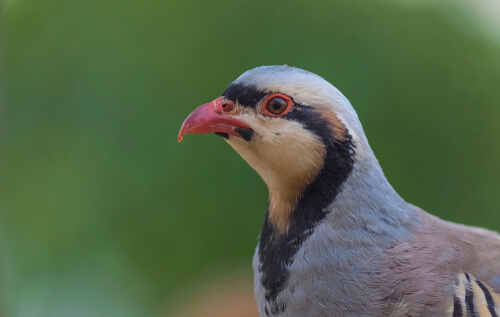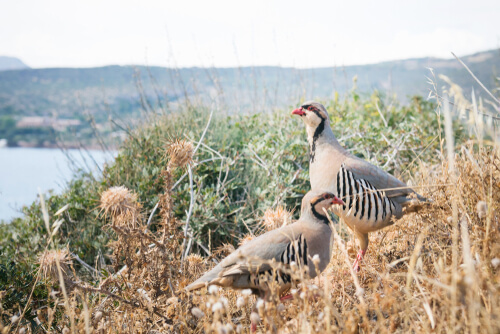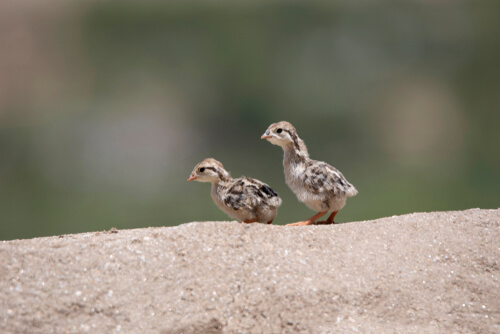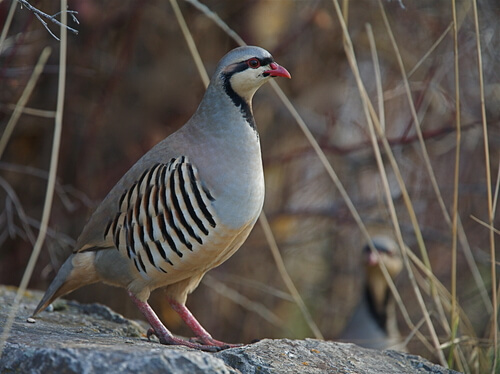
| Kingdom | Animalia |
| Phylum | Chordata |
| Class | Aves |
| Order | Galliformes |
| Family | Phasianidae |
| Genus | Alectoris |
| Species | Alectoris chukar |
| Niche | Seed disperser |
| Length | 13-15 in (32-38 cm) |
| Weight | 19-27 oz (538-765 g) |
| Lifespan | 3-5 years |
| Social Structure | Small groups (10-30 |
| Conservation Status | Least concern |
| Preferred Habitat | Sloped scrublands and grasslands |
| Average Clutch Size | 7-14 eggs |
| Main Food Items and Prey | Seeds, insects, grit |
| Predators | Coyote, bobcat, birds of prey |
The Basics
The chukar (Alectoris chukar) is an upland gamebird belonging to the same family (Phasianidae) as pheasants. A type of partridge, the chukar was once thought to be the same species as rock partridges, Philpy’s partridges, and Przevalski’s partridge. They are native to Asia, the Middle East, and northern Africa, but have been introduced to other parts of the world including North America and New Zealand.

Chukar have small wings and a round body. It has well-marked bands of black and white feathers on its sides. The rest of its body is a light brown or grey color, and vary between populations. Chukar have a white section on their breast and face, delineated by a solid black band forming a necklace-shaped ring. Their eyes are black with a thin red outline, matching their red beak. They have red legs and clawed toes. Males and females appear similar, although the female is slightly smaller and lacks the spur on the legs present in males.
Chukar are native throughout Asia and the middle east, along the inner ranges of the western Himalayas to Nepal. Also, it likely occurs in northern Africa on the Sinai Peninsula. Chukar prefer rocky, grassy, and open hillsides in scrublands. In some areas, they tend to inhabit low altitude areas whereas in others they seem to prefer higher altitudes up to 13,000 ft (4,000 m). Also, chukar populations have been introduced to other parts of the world including New Zealand, Hawaii, and mainland North America, mostly as a game bird for hunters. They are non-migratory, usually maintaining a home range of just a few square miles.
Predators and Threats
Typically chukar will spend their time in small flocks of about ten birds. Outside of the breeding season, they can be found in grassy fields and low-lying mountain valleys. They are often hunted by predatory mammals such as coyotes and bobcats in North America. Larger birds of prey such as owls, hawks, and eagles from around the world will also prey on these relatively easy targets.
Chukars have the ability to fly, although their short wings and relatively rotund body shape keep them on the ground most of the time. Even when disturbed, they prefer to run rather than fly. Humans have long hunted chukar partridges and, of course, introduced them around the world solely for this purpose. In India, for example, people will hunt the birds by a unique technique in which they tire out the birds by forcing it to fly longer than it is able, allowing them to catch them. But unlike many species, chukar partridge are not particularly threatened by habitat loss due to human development.
However, their populations are significantly affected by weather patterns, particularly during the breeding season. As global climate change worsens, one of its impacts is impacting local weather patterns, including changes to the timing of seasonal events and an increase in extreme weather events such as storms. In this way, human activity indeed has an impact on chukar populations and most species.
Chukars themselves are omnivores, subsisting primarily on seeds but also various insects. In more arid parts of their range, some chukar populations will consume succulents to make up for the scarcity of water in their environments.
Nesting and Reproduction
In the breeding season, they will pair up with a mate. Males perform displays for the females, including pecking at food as if feeding. If impressed, the female will often join him in this pecking activity. Males will often chase females with their heads low, wings dropped and feathers ruffled. The effort to find a mate often leads to conflict between cocks (males) that grow more aggressive during this time. Once they do pair up, males will remain monogamous with that female, at least during that particular breeding season.

Following copulation, females will find a spot in the ground for a nest where she lines a small depression in the ground with grass and other soft materials. Typically these nests will be amongst shrubs and small plants for shelter. The female lays about 7-14 eggs, which require 3-4 weeks of incubation before they hatch. Chicks will soon after follow their mothers in foraging and integrate with other female groups to form a convoy again until the next breeding season.
Fun Facts about Chukar!
Spelled Just Like it Sounds
The chukar got its name from its sounds and song, described as a noisy chuck-chuck-chukar-chukar. They make this sound almost frequently, especially in the evenings and mornings. Interestingly, one of their calls has been identified as a ‘rally’ call, used to bring the group together, perhaps in the face of a predator or threat from an incoming storm. In some parts of the world, they go by other names such as keklik and chukker.

The Evolution of Flight
As young chukars are growing, they are unable to fly at all. Instead, they utilize a technique known as “wing-assisted incline running”. Although present in many bird species, it has been studied extensively in chukar and is a model used to explain the evolution of flight avians (birds) in general.
Wing-assisted incline running describes the behavior seen in birds where they will move upslope while flapping their wings. This has been shown to help them move up slopes steeper than they would otherwise be able to without the aid of their wings. In chukar and many other species, this is seen in young birds before learning to fly. However, in some species, this is the extent to which their wings aid them to fly, and is seen as a precursor to actual flight under this model.
Not Like the Others
In the past, chukars have been lumped together with rock partridge (Alectoris graeca) and other partridge species. But the chukar partridge is browner on its back and more yellowish on its light throat section than the rock partridge. The red-legged partridge (Alectoris rufa) is also similar in appearance, but its necklace-shaped band of black feathers around its neck breaks sharply into bands of black and white on its breast, somewhat like the plumage on the flanks of chukar. Finally, the Barbary partridge (Alectoris barbara) has a reddish-brown collar and a grey throat and face, whereas the chukar’s collar is black.
In addition to these subtle discrepancies physical characteristics, these species are often separated by their ranges as well. For example, the chukar occurs throughout the middle east and Asia, but further west into southeastern Europe it is replaced by the red-legged partridge. Despite their similarities and even their ability to interbreed when given the opportunity, they were eventually distinguished as separate species. Their geographical divides likely led to their ultimate speciation, despite sharing a common ancestor. The hybridization of captive stock of these species is indeed illegal in many parts of the world as they are a threat to wild populations.
